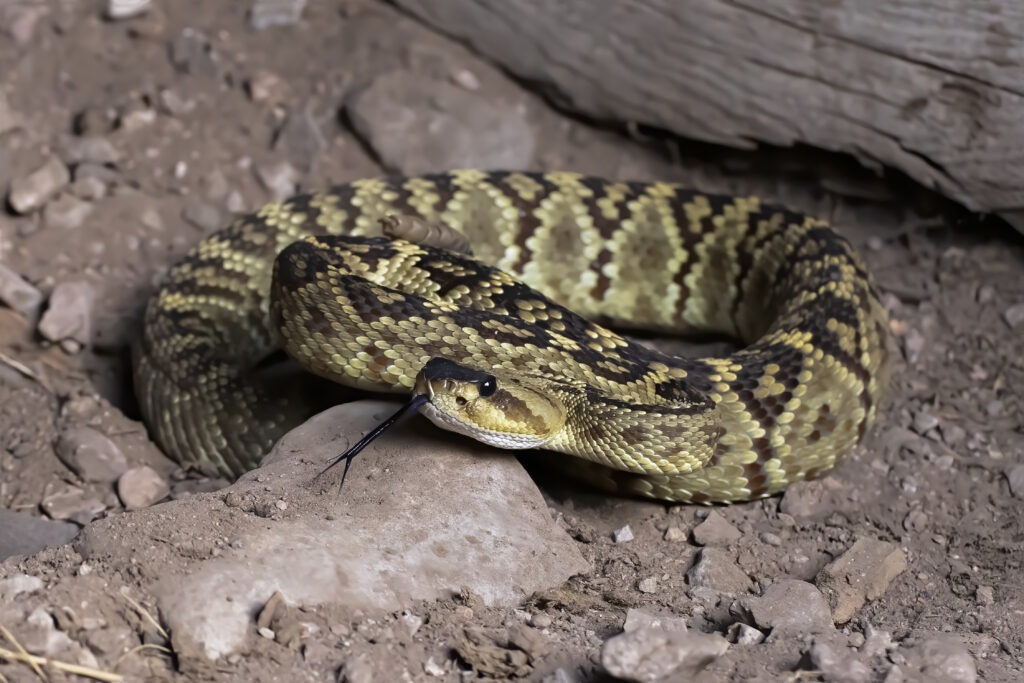It’s a bad experience for everyone if we’re out hiking around and find a rattlesnake that sees us as a threat. While we would rather wear shorts and light clothing to beat the heat, unfortunately, that makes us vulnerable to rattlesnake bites. But can rattlesnakes bite through jeans?
Rattlesnakes can bite through tight-fitting low-quality jeans made of thin material. Heavy denim or canvas offers better protection, especially if they are loose-fitting and not tight against the skin.
Wearing sturdy, closed-toes boots and making your own snake-proof material will protect you better against bites.
We will be going over some of the best snake-proof fabrics and where you can get them. We will also cover other protection methods, such as snake gaiters and chaps.
Lastly, there’s an interesting study about how denim stands up against snake bites.

A Snakebite Study: Denim Vs. Rattlesnake Bites
This study’s objective was to see if normal clothing such as denim from blue jeans interferes with the function of venom delivery.
The researchers wondered if denim would prevent or reduce the amount of venom in each bite. In the lab study, there were models of human limbs made with warm saline solution-filled gloves. Pacific rattlesnakes were used as the test subjects. There was a video documented of the snakes biting both a bare glove and denim-covered glove.
The results indicated that the snakes injected significantly less venom into the denim gloves with a 60% reduction for smaller snakes and 66% for large snakes. Inclusions of the latency to bite, the number of bites, and the duration of the fang contact were similar in both glove types. This gave the impression that the snakes reacted with the same defense procedure no matter what.
Further findings suggested the denim prevented further venom delivery while also including many dry bites with large quantities of venom bites spilled over the denim itself.
Larger rattlesnakes struck more while delivering 26-41 more venom into the gloves than smaller snakes. The study concluded the denim clothing was more effective at reducing venom injection by small and large rattlesnakes. It is advised that wearing denim pants provide low-cost protection to reducing the chances of severe snakebites.

Other Fabrics to Consider: DIY & More
When wearing snake-proof materials, we should wear loose-fitting pants that extend over the boots.
The material needs to be both heavy and comfortable so materials like canvas are great. However, we don’t want the pants to be close to the boot or skin, because there needs to be “dead air” between the snake’s fangs and the boot/pants. If you wear loose-fitting pants, there’s a good chance that a snake will get a mouthful of fabric instead of your leg.
Supplementing pants with anti-snake gaiters or chaps is a big help because of the tough nylon material like Cordura.
When preparing one’s own snakeproof fabric, we need to understand the structure and design of rattlesnake fangs. These snakes have hollow fangs, which are designed to inject venom into their prey. An example would be an eastern diamondback rattlesnake’s fangs that grow to an inch in length and are long enough to pierce deep into the skin.
Because venom is shot through the snake’s fangs with so much force, the results are tissue and blood damage. Therefore the pants need to be able to withstand deep fang punctures as well as having a good thickness, tightness of the weave, and layers.
When it comes to thickness, denim is easier to sew with but is more likely to be punctured by snake bites. Materials like Kelvar and Cordura nylon are unfortunately expensive and harder to sew with, but it is a much stronger substitute. When sewing, use a fat needle/hook while applying more force.
If it’s harder for sewing, it’s better snake-proof material!
Regarding the tightness of the weave, having effective snake-proof fabric like wool or cotton enhances the resistance to snake bites. Plus, the materials have the benefit of being both comfy and breathable. Lastly, layers, are needed as extra barriers against fangs by lining the inside of the pants with soft material and having the outside be tougher material like rawhide between less dense materials.
Having these tips in mind also helps when making DYI snake-proof pants:
- Tear resistance
- Stretch resistance
- Flexibility
- Water-resistance / absorption
- Drying speed
- UV resistance
- Temperature resistance
- Durability
- Breathability
- Wind resistance
- Higher weight fabric (stronger)
- Tighter weave
- Multi-layer
Companies That Provide Manufactured Snake Proof Material:
Snake Gaiters And Chaps
As scary as it is, most snakes can strike as far as 1/3-1/2 of their body length.
They bite generally between ankles, the knee, or the foot. However, the most common place is the leg between the knee and thighs. This is the main area that snake chaps and gaiters aim to protect. It is possible to be bitten on the arms, hands, or face, but this is more of a risk for people who handle snakes.
The snake gaiters and chaps protect people who accidentally step too close to the snake. Source
It offers an extra layer of protection, plus they have an adjustable fit and are lightweight. It is advisable to wear a snake gaiter with metatarsal protection (placed on the top of the foot). Otherwise, it’s best to wear a good pair of thick boots/snake-proof boots.
Check out the great selection of snake gaiters and chaps on Amazon.

Tips To Prevent Snake Bites
1. Be careful around places snakes like to hide
- Don’t go near piles of leaves or tall grass
- Logs and rock formations are places snakes will ambush or wait for prey.
- Do not climb rocks or piles of wood as snakes will hide here
- Be aware that snakes are active at night in warm areas
- Wear long pants and boots when outside
- When handling brush and debris, wear leather gloves
2. Stay on hiking trails
- Avoid underbrush and tall weeds
- Avoid extreme temperatures if possible
- Prevent children from going off hiking paths
3. Do not touch/disturb a snake
- Even if it appears dead, do not touch it. (They attack by surprise and freshly killed snakes can still bite)
4. Always look for concealed snakes
- Look under concealed rocks or sticks before picking anything up. Rattlesnakes are known for their camouflaging skills and they often hide under piles of rocks, logs, dense shrubs, and tall grass.
5. Never hike alone
- Always have a partner to assist in snake bite medical emergencies. Photograph the snake to aid in identifying the proper treatment
6. Teach kids to leave snakes alone
- Much like teaching children to look both ways to cross a street for having the right away, children need to be taught to give snakes the same right of way and leave them alone to prevent future snake bites.
If bitten, call 1-800-222-1222 to access poison information experts who are available 24 hours a day, 365 days a year.
As an Amazon Associate I may earn a small comission from qualifying purchases if you click to Amazon from my site and choose to make a purchase. You can read my complete affiliate disclosure for more details.
